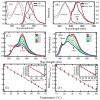Ratiometric temperature sensing with semiconducting polymer dots
- PMID: 21548583
- PMCID: PMC3109500
- DOI: 10.1021/ja202945g
Ratiometric temperature sensing with semiconducting polymer dots
Abstract
This communication describes ultrabright single-nanoparticle ratiometric temperature sensors based on semiconducting polymer dots (Pdots). We attached the temperature sensitive dye-Rhodamine B (RhB), whose emission intensity decreases with increasing temperature-within the matrix of Pdots. The as-prepared Pdot-RhB nanoparticle showed excellent temperature sensitivity and high brightness because it took advantage of the light harvesting and amplified energy transfer capability of Pdots. More importantly, the Pdot-RhB nanoparticle showed ratiometric temperature sensing under a single wavelength excitation and has a linear temperature sensing range that matches well with the physiologically relevant temperatures. We employed Pdot-RhB for measuring intracellular temperatures in a live-cell imaging mode. The exceptional brightness of Pdot-RhB allows this nanoscale temperature sensor to be used also as a fluorescent probe for cellular imaging.
© 2011 American Chemical Society
Figures



References
-
- DeBerardinis RJ, Lum JJ, Hatzivassiliou G, Thompson CB. Cell metabolism. 2008;7:11–20. - PubMed
-
- Borisov S, Klimant I. J Fluor. 2008;18:581–589. - PubMed
-
- Peng HS, Huang SH, Wolfbeis O. J Nanopart Res. 2010;12:2729–2733.
-
- Peng H, Stich MIJ, Yu J, Sun Ln, Fischer LH, Wolfbeis OS. Adv Mater. 2010;22:716–719. - PubMed
-
- Yu J, Sun L, Peng H, Stich MIJ. J Mater Chem. 2010;20:6975–6981.
Publication types
MeSH terms
Substances
Grants and funding
LinkOut - more resources
Full Text Sources
Other Literature Sources

